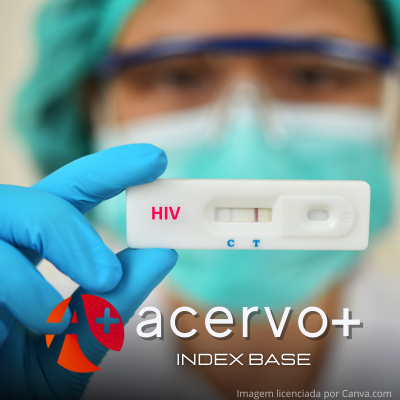Factors associated with HIV/STI co-infection in patients treated at an assistance service of infectious diseases of the SUS
##plugins.themes.bootstrap3.article.main##
Resumen
Objective: To investigate the association between socioeconomic factors and health with co-infection with HIV from 2017 to 2021 in a city in Minas Gerais, Brazil. Methods: A retrospective study was conducted with 298 adults with co-infection (yes/no). The exposure variables included sex, age, sexual orientation, skin color, education, income, marital status, health plan, fixed partnership, form of exposure, partnership serology, condom use, adherence to treatment, and adverse reactions. Pearson's chi-square tests were used (p<0.05), and the Odds Ratio (OR) was estimated by univariate regression. Results: More patients were male, mixed race, 21 and 60 years old, heterosexual, single, with low education and income. They also had a stable and seroconcordant partnership, sexual contagion, little use of condoms, adherence to antiretroviral drugs, and few adverse events. There was an association between HIV co-infection with syphilis, gonorrhea, and HPV, with significance for the male gender (OR 4.6), bisexual (OR 3.1), homosexual (OR 2.7), and serodiscordant partnership (OR 3.2). Conclusion: The study identified an increase in the prevalence of co-infection and highlighted the importance of health education to ensure actions to prevent co-infections, treatment, and improvement of the living conditions of patients living with HIV/AIDS.
##plugins.themes.bootstrap3.article.details##
Copyright © | Todos los derechos reservados.
La revista posee los derechos de autor exclusivos para la publicación de este artículo en los términos de la ley brasileña 9610/98.
Reproducción parcial
El uso de partes de los textos, figuras y cuestionario del artículo es libre, siendo obligatoria la citación de los autores y revista.
Reproducción total
Está expresamente prohibido y debe ser autorizado por la revista.
Citas
2. BRASIL. Ministério da Saúde. Indicadores e Dados Básicos do HIV/AIDS nos Municípios Brasileiros. SVSA/Departamento de HIV/Aids, Tuberculose, Hepatites Virais e Infecções Sexualmente Transmissíveis (Dathi). Brasília: Ministério da Saúde, s.d.a. Disponível em> https ://indicadores.aids.gov.br/. Acessado em 16 de julho de 2024.
3. BRASIL. Ministério da Saúde. Portaria GM/MS nº 420, de 2 de março de 2022. Disponível em: https ://www.in.gov.br/en/web/dou/-/portaria-gm/ms-n-420-de-2-de-marco-de-2022-383578277 Acessado em 13 de julho de 2024.
4. BRASIL. Ministério da Saúde. Prevenção Combinada. Departamento de HIV/Aids, Tuberculose, Hepatites Virais e ISTs. s.d.c. Disponível em: https ://www.gov.br/aids/pt-br/assuntos/prevencao-combinada . Acessado em 14 de julho de 2024.
5. BRASIL. Ministério da Saúde. Protocolo clínico e diretrizes terapêuticas para atenção integral às pessoas com infecções sexualmente transmissíveis (IST), 2022. Disponível em: http ://bvsms.saude.gov.br/bvs/publicacoes/protocolo_clinico_atecao_integral_ist.pdf. Acessado em 15 de julho de 2024.
6. BRASIL. Ministério da Saúde. Protocolo Clínico e Diretrizes Terapêuticas para Manejo da Infecção pelo HIV em Adultos Módulo 1: Tratamento; 2023. Disponível em: https ://www.gov.br/saude/pt-br/centrais-de-conteudo/publicacoes/svsa/aids/protocolo-clinico-e-diretrizes-terapeuticas-para-manejo-da-infeccao-pelo-hiv-em-adultos-modulo-1-tratamento/view Acessado em: 15 de julho de 2024.
7. BRASIL. Ministério da Saúde. Secretaria de Vigilância em Saúde. Departamento de Doenças de Condições Crônicas e Infecções Sexualmente Transmissíveis. Boletim Epidemiológico HIV Aids. Número Especial/Dez. 2023. Disponível em: https ://www.gov.br/aids/pt-br/central-de-conteudo/boletins-epidemiologicos/2023/hiv-aids/boletim-epidemiologico-hiv-e-aids-2023.pdf/view . Acessado em 13 de julho de 2024.
8. BRASIL. Presidência da República. Lei nº 8.080, de 19 de setembro de 1990. Disponível em: https ://www.planalto.gov.br/ccivil_03/leis/l8080.htm . Acessado em 17 de julho de 2024.
9. BUCHACZ K, et al. Syphilis increases HIV viral load and decreases CD4 cell counts in HIV-infected patients with new syphilis infections. AIDS, 2004; 18(15): 2075.
10. KALICHMAN SC, et al. Prevalence of sexually transmitted co-infections in people living with HIV/AIDS: systematic review with implications for using HIV treatments for prevention. Sex Transm Infect, 2011; 87(3): 183.
11. NETO LFSP, et al. Protocolo brasileiro para Infecções Sexualmente Transmissíveis 2020: infecção pelo HIV em adolescentes e adultos. Epidemiol. Serv. Saúde, 2021; 30(1): 2020588: 1-13.
12. PINTO NETO LF DA S, et al. Brazilian Protocol for Sexually Transmitted Infections, 2020: HIV infection in adolescents and adults. Rev Soc Bras Med Trop, 2021; 54: 2020588.
13. SANTOS AO, et al. A pesquisa em saúde no Brasil: desafios a enfrentar. Saúde Debate, 2019; 43(5): 126.
14. SILVA BG, et al. HIV, syphilis, hepatitis B and C in key populations: results of a 10-year cross-sectional study, Southern Brazil. Einstein 2022; 20(eAO6934).
15. SIMÕES LA, et al. Factors associated with HIV/syphilis co-infection initiating of antiretroviral therapy. Rev Saúde Pública 2022; 56: 59.
16. UNAIDS. Ending AIDS progress towards the 90-90-90 targets. Joint United Nations Programme on HIV/AIDS. UNAIDS; 2017. Disponível em: https ://www.unaids.org/en/resources/documents/2017/20170720_Global_AIDS_update_2017. Acesso em: 24 de junho de 2024.
17. WHO. World Health Organization. Guidelines for Managing Advanced HIV Disease dnd Rapid Initiation of Antiretroviral Therapy. World Health Organization; 2017 Disponível em: https ://www.who.int/hiv/pub/guidelines/advanced-HIV-disease/en/. Acesso em 10 de junho de 2024.

